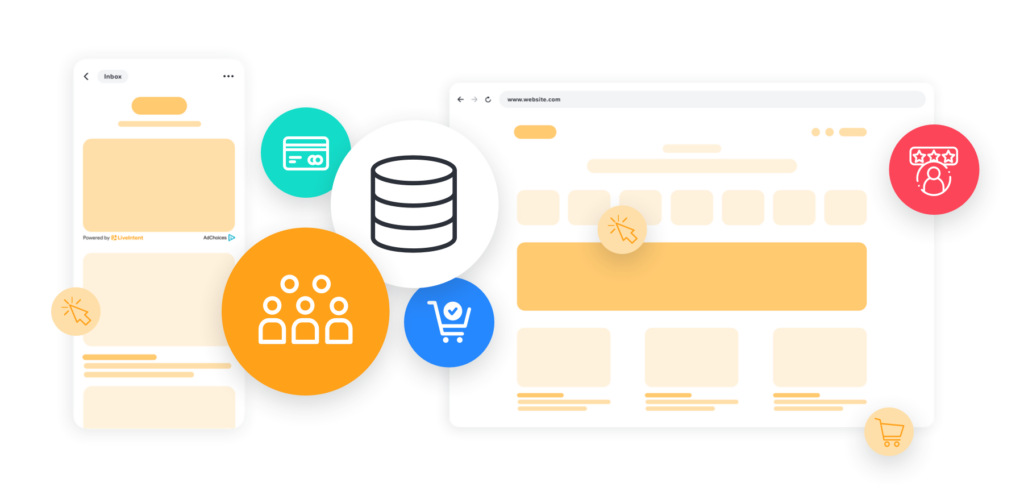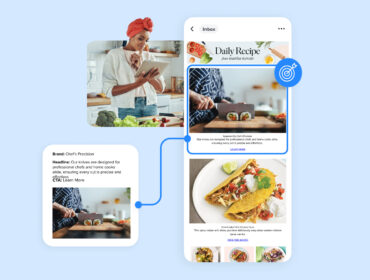Retail media networks: Everything you need to know
Major brands like Walmart, Target, CVS, and Kroger have launched their own retail media networks. This venture into media has been very lucrative for these retailers. In fact, big retailers are headed toward a $100 billion annual margin in retail media alone.

These big retailers are further solidifying their presence in eCommerce and retail through their own retail media networks. This does not mean, however, that small-to-medium-sized retailers cannot remain competitive. SMBs can implement similar strategies to launch retail media networks that help drive revenue.
In this blog post, we’ll explore:
- Why big retailers have ventured into retail media
- The advantages retail media networks give retailers
- How retailers can stay competitive, and the role email will play
What is a retail media network?
A retail media network is a proprietary advertising platform launched by a retailer, enabling advertising on their websites, apps, email newsletters, and other digital properties. By allowing advertising on these properties, retailers help brands leverage insights to reach their shoppers via advertisements in exchange for monetary compensation.
Why have retailers launched retail media networks?
The short answer to that question is revenue. Tremendous revenue opportunities are generated through retail media networks, and these revenue opportunities are rooted in first-party data. Let’s take a closer look.
First-party data
Retailers have amassed troves of first-party data from their customers and audiences like information on purchases (both online and in-store), loyalty programs, store credit cards, and rebates, for example. All this information enables retailers to understand their customers’ interests and needs clearly. These audience insights present valuable revenue opportunities.

Retailers can offer advertisers the opportunity to get in front of audiences that exhibit behaviors or traits inline with their ideal customer profile. This approach to using first-party data is not unlike how publishers have come to understand their audiences and designed advertising experiences to monetize their digital properties.
Mitigate risk with business diversification
Big-box retailers are careful not to place all their eggs in one basket. By diversifying business portfolios, not only are retailers capitalizing on the data that’s readily available by launching retail media networks, but they’re also diversifying their revenue strategy. By diversifying, businesses mitigate the risk of industry downturns and protect themselves from fierce competition (here’s looking at you, Amazon).
How retailers capture first-party data
There are several ways by which big-box retailers capture first-party data. Let’s take Target as an example. Target’s customers may choose to shop online, in-store, or both. If they shop online, they’ll have to create an account with Target. This account is tied to an email address, which is also connected to their home address for order delivery.
The same customer may also sign up for Target’s reward program, Circle. The Circle program provides several perks like birthday gifts (yay!) and earnings on purchases. Here’s how Target enables its Circle program members to earn by shopping with Target.
- In-store: A customer enters their mobile number
- Online with their Target account: A customer logs into their account, which is tied to their email
- In-store or online with Target’s RedCard: A customer uses the store’s credit card, which is associated with their full name, email, mobile number, and much more
Every interaction customers have with Target enables the retailer to capture a small data point. When retailers implement loyalty programs, store credit cards, and various ways to shop with their business, it becomes increasingly easy for a retailer to further engage with their customers and capture more shopper data and interactions. This approach enables Target to grow its first-party data and further understand its customers.
Drawing audience insights from first-party data
These methods of shopping with Target (RedCard and Circle) all have something in common; they enable retailers to get a clear picture of their customers, who they are, what they need, and what they want. So, whenever a customer shops with Target, Target gains more insights into that customer’s shopping habits and behaviors.
Imagine for a moment that one of Target’s customers is a man in his mid-thirties named Nelson. Nelson lives in Long Island, NY, and he’s really into fitness. He regularly purchases Gatorade, his favorite post-workout drink, protein powders and bars to meet his caloric needs, and workout gear (he’s a men’s medium and working on his gains!), using Target’s reward program, Circle. Nelson is also a dad and buys diapers and formula online and toys for Nelson Jr. in-store.

Based on Nelson’s purchases, Target can deduce that Nelson cares about fitness because he regularly buys protein products and workout gear. They also know Gatorade is one of his at-home staples, given the volume and frequency of those purchases. Target also knows Nelson lives in Long Island because of where his online orders ship and that his preferred Target is in Commack, NY because that’s the location where he almost exclusively shops. They also know that Nelson is either a primary caregiver for a young child, thanks to all the diaper and formula purchases. All these data points present highly valuable opportunities for Target to drive revenue.
How to activate first-party data to drive revenue
Like publishers, retailers have their own audiences. Every person that comes to a retailer’s website becomes part of their audience base. And, like publishers, retailers can monetize their online properties to drive incremental revenue as many of these retail giants, like Target, have done.
Retailers of all sizes can use their audiences and audience insights to provide brands with the opportunity to get in front of audiences with proven interests in specific products or lifestyles or with the ideal customer profile they’re looking for. However, not all businesses have the resources to launch their own retail media networks like some of these big-box retailers. So, how can other companies play ball with those that have established retail media networks? The answer sits with email.
Remember Nelson? Nelson gave Target his email address to become a member of its Circle reward program and to secure Target’s store credit card. Not only is Nelson’s email address the key to unlocking fantastic retailer perks, but it’s also a direct line of communication between Target and Nelson. Order confirmations, exclusive offers, and weekly reminders are all shared by Target with Nelson through email.
Email is one of the few direct one-to-one channels that retailers have with their customers. Email newsletters are also another property, outside of websites, that retailers can use to generate revenue. And with as many as 87 percent of marketers using email marketing to disseminate their content, unlocking revenue by leveraging email newsletters and first-party data is within arm’s reach for many.

Now, whether you’re running a seasoned email newsletter program or are just beginning to consider one, email newsletters are a critical first step to not only capturing first-party data and building your data footprint, but also activating it to generate revenue. And, like retail media networks, email is your proprietary channel that helps you take control of your data, how it’s used and how you commercialize it.
Retailers can open their email newsletters to third-party demand, transforming email from a distribution channel to a net-new revenue source. Like publishers, retailers of all sizes can offer brand partners the opportunity to engage audiences with specific interests, shopping habits, or customer profiles. Instead of launching an entire retail media network, smaller retailers or those looking to adopt digital-first approaches can lean on their email newsletters to commercialize their first-party data and drive incremental revenue. Not only does this approach open new revenue opportunities for retailers, but it also enables them to diversify their revenue streams.
Understand your customers
Retailers must understand who their customers are to successfully provide advertising partners with lucrative opportunities for engagement while also delivering a quality experience for their email newsletter readers. Relevance and personalization are always key. For instance, a person who never expresses interest in vegan products likely doesn’t want to hear about a brand’s new meatless burger, and brands only want to get in front of the audiences most likely to convert. Use your audience data insights to offer and drive the best digital experiences for your advertisers and your customer.
Using audience data and insights
Let’s say you own a few successful bookstores throughout New England and decided to place ad inventory in your email newsletters to drive extra revenue. You have various email newsletters segmented by audience interest like arts and culture, child-rearing, and spirituality, to name a few. Yoga studios and spiritual associations may choose to advertise in your email newsletters to reach audiences interested in eastern religions or on the topic of spirituality, for instance. Brands for children’s clothes may decide to advertise in your email newsletter but specifically in your child-rearing category. You can offer your inventory to the many New England museums and universities with opportunities to reach audiences most interested and invested in arts and culture, for example, or those who meet their specific age demographics.
Retailers like Target leverage their customer insights to deliver customized marketing experiences with promotional emails containing coupons or special offers. So, say your demand for your ad inventory is a little low. You can run campaigns promoting your own products in your email newsletters. This tactic also helps ensure you’re making the most of your email ad inventory even when third-party demand is low. Here’s how a retailer like Target might choose to leverage email ad inventory for their own marketing purposes.
Cross-selling campaigns:
Take Nelson and his son, Nelson Jr, for example. Target can reach Nelson with several marketing campaigns by leveraging its first-party data on Nelson’s purchase history. For instance, Target could provide Nelson with emails promoting products that complement recent diaper purchases like Target’s store-brand wipes, rash cream, or diaper bags.
Re-engagement campaigns:
Maybe Nelson hasn’t bought Gatorade in over two weeks when he usually purchases Gatorade every five days. Target could send Nelson a discount offer for his next Gatorade purchase to incentivize him to buy again or an offer for their store-brand product if Nelson feels like trying out something new.
Seasonal campaigns:
Since Target knows that Nelson has a baby in his life, they may also choose to provide Nelson with marketing for children’s products during key shopping seasons like Halloween or the holidays. Will Nelson resist imagining Nelson Jr. in a cookie monster costume or trying on his first pair of sneakers on Christmas morning? Probably not.
Other personalized campaigns:
Remember Target’s RedCircle perks? Target sends a special birthday gift to their members — this is a prime example of how a retailer can create a relationship through customization and personalization. As a retailer, you can find opportunities to deliver a special touch for your customers, so they know you care all by using your first-party data.
Put the right tech in place
If you already have an email newsletter program in place, then you’re already off to a great start — and if you don’t, get going! Now that you have some insight into retail media networks, what they are, and how they work, you’re ready to take steps in launching your own version of a retail media network. With the right partners and tech in place, you can start capturing first-party data, growing your data footprint, and using your data to generate revenue.
LiveIntent helps retailers every day to monetize their email newsletters and drive premium digital experiences for their advertisers and audiences. And as you learned today, retail media networks are no different than what publishers have been doing for years. If you’re interested in learning more about how you can leverage your first-party data and email newsletters to drive revenue, please contact us today or check out these resources to learn more:


